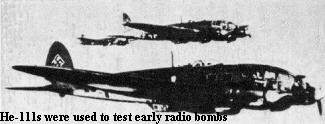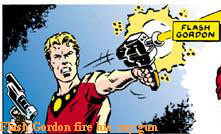|
"There is a need to destroy with pinpoint accuracy..." -- 1950s Pentagon Study Guided weapons were nothing new to the United States military, even in 1965. The concept dated
back to the Germans and World War II. German scientists developed the FRITX-X and the HS-293 both based on radio controlled guidance. These were used by the German Luftwaffe to destroy the Italian
battleship Roma on September 3, 1943 because the Italians were going to turn the ship over to the Allies. At the end of World War II, the U.S. Army Air Force had used radio guided bombs to destroy bridges in
Burma, and then again five years later in Korea. The weapons were difficult to use, hard to maintain and because of radio control problems often were unreliable, but they proved guided weapons were a
reality.
However, the str ategic thinking of the 1950s revolved around bombs large enough to destroy cities, not bridges. The Pentagon promptly
abandoned guided weapon development,. promising as it was, for a larger concept, that of nuclear weapons. For the most part, during the 1950s, guided air-to-ground weapons were a
neglected step child. The favored approach was to use a blunt sledgehammer type nuclear weapon and not a surgical scalpel to take out targets. ategic thinking of the 1950s revolved around bombs large enough to destroy cities, not bridges. The Pentagon promptly
abandoned guided weapon development,. promising as it was, for a larger concept, that of nuclear weapons. For the most part, during the 1950s, guided air-to-ground weapons were a
neglected step child. The favored approach was to use a blunt sledgehammer type nuclear weapon and not a surgical scalpel to take out targets.
The U.S. Navy and Air Force had been using radio guided weapons for a few years by the time the air war began over Southeast Asia. However, the bombs had unreliable guidance
packages, and when they did hit a target the small warheads were not enough to destroy an object as large and well made as a bridge. In the case of the 1965 Than Hoa raid, pilots
reported the bombs simply bounced off the bridge with no noticeable damage to the French made structure.
Word started thinking along lines that would get American
bombs closer to their intended targets. An engineer with Texas Instruments, Word had been working on a submarine detection net off the New England coast and was looking for
more challenging work when he crossed paths with laser engineer Dave Salonimer, in late 1964. Salonimer was trying to convince the U.S. Army to use a laser targeting sys tem for artillery strikes. "Dave had conceived this idea of the
Army artillery using a laser. Well, Salonimer thought wouldn't it be great if you could take a flashlight, ala a laser, mark a target, and then send a missile or a shell or
whatever over the hill and hit it," Word said. "Those where the serious early thoughts about laser guidance." tem for artillery strikes. "Dave had conceived this idea of the
Army artillery using a laser. Well, Salonimer thought wouldn't it be great if you could take a flashlight, ala a laser, mark a target, and then send a missile or a shell or
whatever over the hill and hit it," Word said. "Those where the serious early thoughts about laser guidance."
Within the military, however, there were no takers for
Salonimer's "Buck Rogers" idea of using lasers to guide projectiles, and in late 1964 the Huntsville, Alabama based scientist wanted Texas Instruments to devise a way to launch
a Shrike air launched anti-radar missile from the ground then use a laser guidance system to guided the missile to a marked target. It all sounds easy, today, for the buddy lasing tactic is
standard work for the U.S. Army and Air Force, but in 1964 it was still the stuff of science fiction.
Adapting an air launched missile for ground use wasn't easy
either, remembers TI engineer Tom Weaver. "We started looking at the use of the Shrike airframe, which is not very good I might add, but it was low cost and simple to make,"
Weaver said. "It looked promising, enough for a demo contract anyway, but nothing came of it."
|
|
 ategic thinking of the 1950s revolved around bombs large enough to destroy cities, not bridges. The Pentagon promptly
abandoned guided weapon development,. promising as it was, for a larger concept, that of nuclear weapons. For the most part, during the 1950s, guided air-to-ground weapons were a
neglected step child. The favored approach was to use a blunt sledgehammer type nuclear weapon and not a surgical scalpel to take out targets.
ategic thinking of the 1950s revolved around bombs large enough to destroy cities, not bridges. The Pentagon promptly
abandoned guided weapon development,. promising as it was, for a larger concept, that of nuclear weapons. For the most part, during the 1950s, guided air-to-ground weapons were a
neglected step child. The favored approach was to use a blunt sledgehammer type nuclear weapon and not a surgical scalpel to take out targets.  tem for artillery strikes. "Dave had conceived this idea of the
Army artillery using a laser. Well, Salonimer thought wouldn't it be great if you could take a flashlight, ala a laser, mark a target, and then send a missile or a shell or
whatever over the hill and hit it," Word said. "Those where the serious early thoughts about laser guidance."
tem for artillery strikes. "Dave had conceived this idea of the
Army artillery using a laser. Well, Salonimer thought wouldn't it be great if you could take a flashlight, ala a laser, mark a target, and then send a missile or a shell or
whatever over the hill and hit it," Word said. "Those where the serious early thoughts about laser guidance."